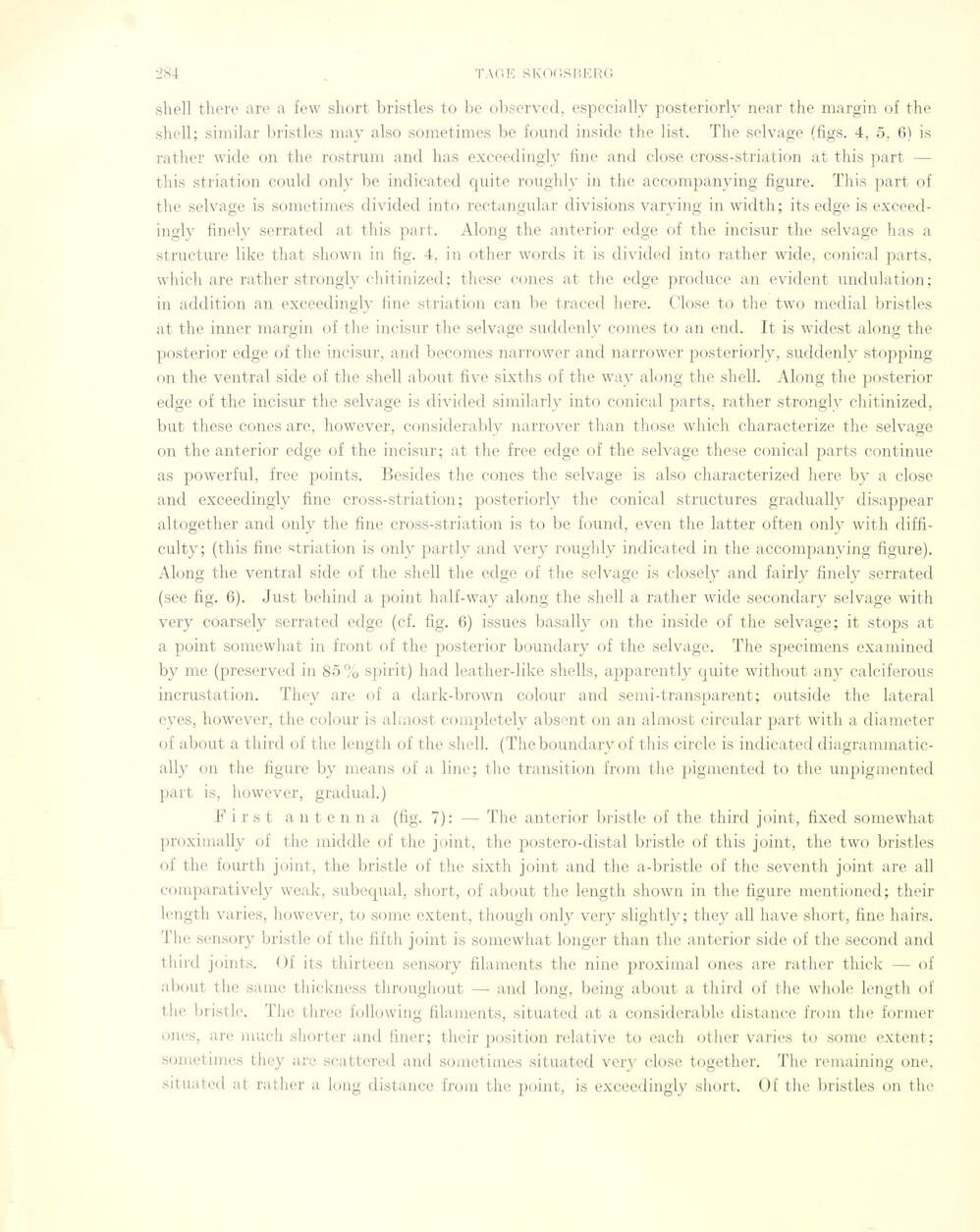
Full resolution (JPEG) - On this page / på denna sida - Sidor ...

<< prev. page << föreg. sida << >> nästa sida >> next page >>
Below is the raw OCR text
from the above scanned image.
Do you see an error? Proofread the page now!
Här nedan syns maskintolkade texten från faksimilbilden ovan.
Ser du något fel? Korrekturläs sidan nu!
This page has never been proofread. / Denna sida har aldrig korrekturlästs.
sliell there are a few short bristles to be observed, especially posteriorly near the margin of the
shell; similar bristles may also sometimes be found inside the list. The selvage (figs. 4, 5, 6) is
rather wide on the rostrum and has exceedingly fine and close cross-striation at this part —
this striation could only be indicated quite roughly in the accompanying figure. This part of
the selvage is sometimes divided into rectangular divisions varying in width; its edge is
exceedingly finely serrated at this part. Along the anterior edge of the incisur the selvage has a
structure like that shown in fig. 4, in other words it is divided into rather wide, conical parts,
which are rather strongly chitinized; these cones at the edge produce an evident undulation;
in addition an exceedingly fine striation can be traced here. Close to the two medial bristles
at the inner margin of the incisur the selvage suddenly comes to an end. It is widest along the
posterior edge of the incisur, and becomes narrower and narrower posteriorly, suddenly stopping
on the ventral side of the shell about five sixths of the way along the shell. Along the posterior
edge of the incisur the selvage is divided similarly into conical parts, rather strongly chitinized,
but these cones arc, however, considerably narrover than those which characterize the selvage
on the anterior edge of the incisur; at the free edge of the selvage these conical parts continue
as powerful, free points. Besicles the cones the selvage is also characterized here by a close
and exceedingly fine cross-striation; posteriorly the conical structures gradually disappear
altogether and only the fine cross-striation is to be found, even the latter often only with
diffi-culty; (this fine striation is only partly and very roughly indicated in the accompanying figure).
Along the ventral side of the shell the edge of the selvage is closely and fairly finely serrated
(see fig. 6). Just behind a point half-way along the shell a rather wide secondary selvage with
very coarsely serrated edge (cf. fig. 6) issues basally on the inside of the selvage; it stops at
a point somewhat in front of the posterior boundary of the selvage. The specimens examined
by me (preserved in 85% spirit) had leather-like shells, apparent ly quite witkout any calciferous
incrustation. They are of a dark-brown colour and semi-transparent; outside the lateral
eyes, however, the colour is almost completely absent on an almost circular part with a diameter
of about a third of the length of the shell. (The boundary of this circle is indicated
diagrammatic-ally on the figure by means of a line; the transition from the pigmented to the unpigmented
part is, however, graduai.)
First antenna (fig. 7): — The anterior bristle of the third joint, fixée! somewhat
proximally of the middle of the joint, the postero-distal bristle of this joint, the two bristles
of the fourth joint, the bristle of the sixth joint and the a-bristle of the seventh joint are ail
comparatively weak, subequal, short, of about the length shown in the figure mentioned; their
length varies, however, to so me extent, though only very slightly; they all have short, fine hairs.
The sensory bristle of the fifth joint is somewhat longer than the anterior side of the second and
third joints. Of its thirteen sensory filaments the nine proximal ones are rather thick — of
about the same thickness throughout — and long, being about a third of the whole length of
the bristle. The three following filaments, situated at a considérable distance from the former
ones, are much shorter and finer; their position relative to each other varies to sonie extent;
sometimes they are scattered and sometimes situated very close together. The remaining one.
situated at rather a long distance from the point, is exceedingly short. Of the bristles on the
<< prev. page << föreg. sida << >> nästa sida >> next page >>